大家写中后台系统的时候,应该都用过 Ant Design 的 Form 组件:
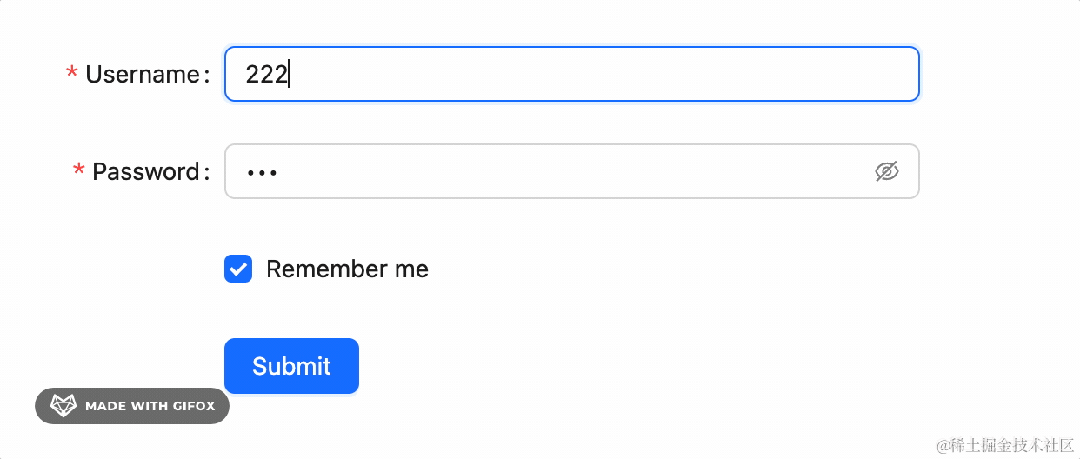

用 Form.Item 包裹 Input、Checkbox 等表单项,可以定义 rules,也就是每个表单项的校验规则。
外层 Form 定义 initialValues 初始值,onFinish 当提交时的回调,onFinishFailed 当提交有错误时的回调。
Form 组件每天都在用,那它是怎么实现的呢?
其实原理不复杂。
每个表单项都有 value 和 onChange 参数,我们只要在 Item 组件里给 children 传入这俩参数,把值收集到全局的 Store 里。

这样在 Store 里就存储了所有表单项的值,在 submit 时就可以取出来传入 onFinish 回调。
并且,还可以用 async-validator 对表单项做校验,如果有错误,就把错误收集起来传入 onFinishFailed 回调。
那这些 Item 是怎么拿到 Store 来同步表单值的呢?
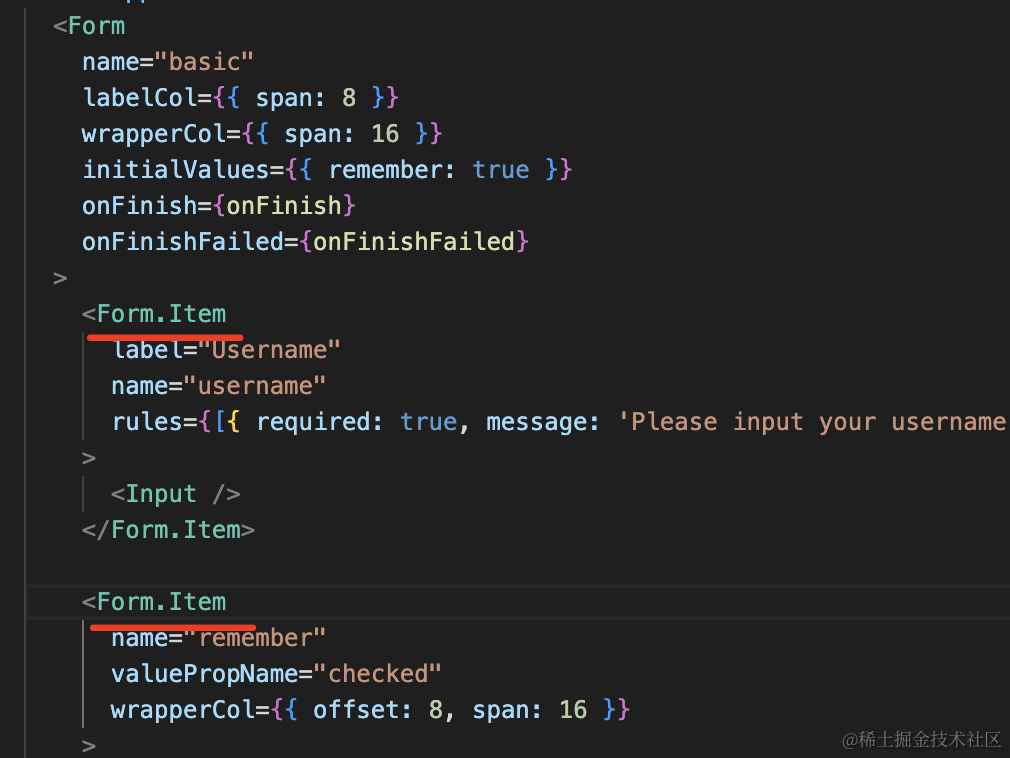
用 Context。
在 Form 里保存 Store 到 Context,然后在 Item 里取出 Context 的 Store 来,同步表单值到 Store。
我们来写下试试:
npx create-vite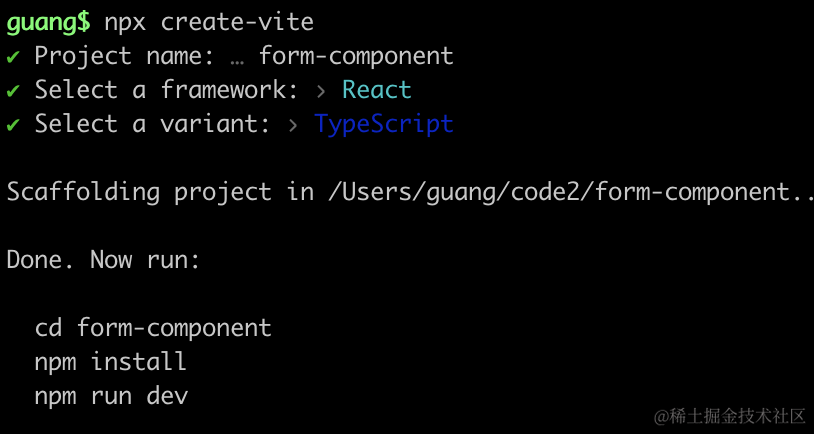
安装依赖,改下 main.tsx
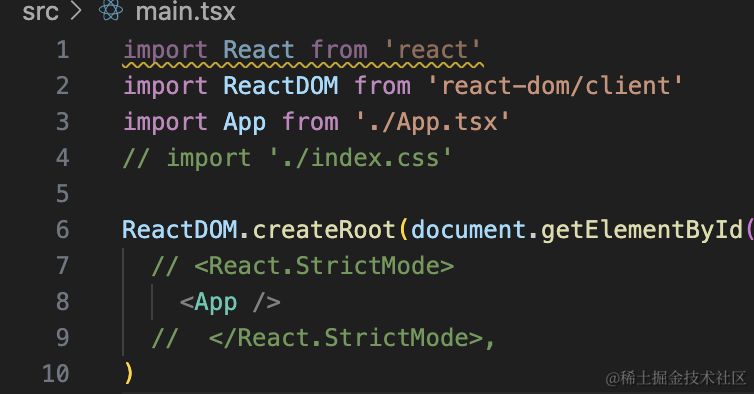
然后创建 Form/FormContext.ts
import { createContext } from 'react';
export interface FormContextProps {
values?: Record<string, any>;
setValues?: (values: Record<string, any>) => void;
onValueChange?: (key: string, value: any) => void;
validateRegister?: (name:string, cb: Function) => void;
}
export default createContext<FormContextProps>({})在 context 里保存 values 也就是 Store 的值。
然后添加 setValues 来修改 values
onValueChange 监听 value 变化
validateRegister 用来注册表单项的校验规则,也就是 rules 指定的那些。
然后写下 Form 组件 Form/Form.tsx
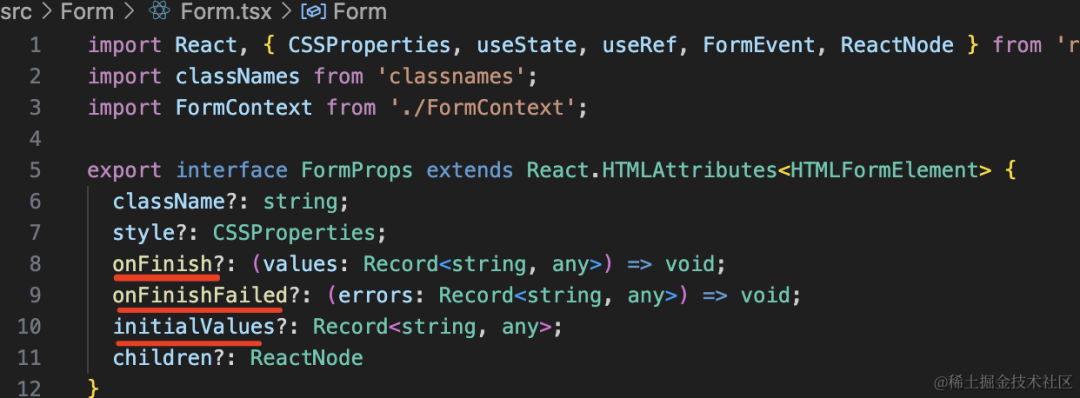
参数传入初始值 initialValues、点击提交的回调 onFinish、点击提交有错误时的回调 onFinishFailed。
这里的 Record<string,any> 是 ts 的类型,任意的对象的意思。
用 useState 保存 values,用 useRef 保存 errors 和 validator

为什么不都用 useState 呢?
因为修改 state 调用 setState 的时候会触发重新渲染。
而 ref 的值保存在 current 属性上,修改它不会触发重新渲染。
errors、validator 这种就是不需要触发重新渲染的数据。
然后 onValueChange 的时候就是修改 values 的值。
submit 的时候调用 onFinish,传入 values,再调用所有 validator 对值做校验,如果有错误,调用 onFinishFailed 回调:

然后把这些方法保存到 context 中,并且给原生 form 元素添加 onSubmit 的处理:
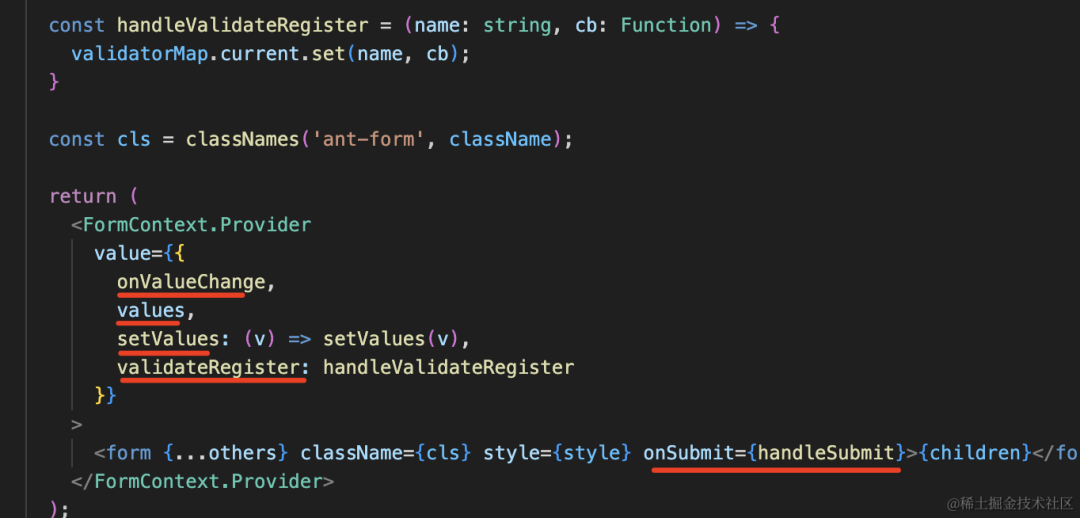
import React, { CSSProperties, useState, useRef, FormEvent, ReactNode } from 'react';
import classNames from 'classnames';
import FormContext from './FormContext';
export interface FormProps extends React.HTMLAttributes<HTMLFormElement> {
className?: string;
style?: CSSProperties;
onFinish?: (values: Record<string, any>) => void;
onFinishFailed?: (errors: Record<string, any>) => void;
initialValues?: Record<string, any>;
children?: ReactNode
}
const Form = (props: FormProps) => {
const {
className,
style,
children,
onFinish,
onFinishFailed,
initialValues,
...others
} = props;
const [values, setValues] = useState<Record<string, any>>(initialValues || {});
const validatorMap = useRef(new Map<string, Function>());
const errors = useRef<Record<string, any>>({});
const onValueChange = (key: string, value: any) => {
values[key] = value;
}
const handleSubmit = (e: FormEvent) => {
e.preventDefault();
for (let [key, callbackFunc] of validatorMap.current) {
if (typeof callbackFunc === 'function') {
errors.current[key] = callbackFunc();
}
}
const errorList = Object.keys(errors.current).map(key => {
return errors.current[key]
}).filter(Boolean);
if (errorList.length) {
onFinishFailed?.(errors.current);
} else {
onFinish?.(values);
}
}
const handleValidateRegister = (name: string, cb: Function) => {
validatorMap.current.set(name, cb);
}
const cls = classNames('ant-form', className);
return (
<FormContext.Provider
value={{
onValueChange,
values,
setValues: (v) => setValues(v),
validateRegister: handleValidateRegister
}}
>
<form {...others} className={cls} style={style} onSubmit={handleSubmit}>{children}</form>
</FormContext.Provider>
);
}
export default Form;这里用到了 classnames 包要安装下:
npm install --save classnames接下来添加 Form/Item.tsx,也就是包装表单项用的组件:
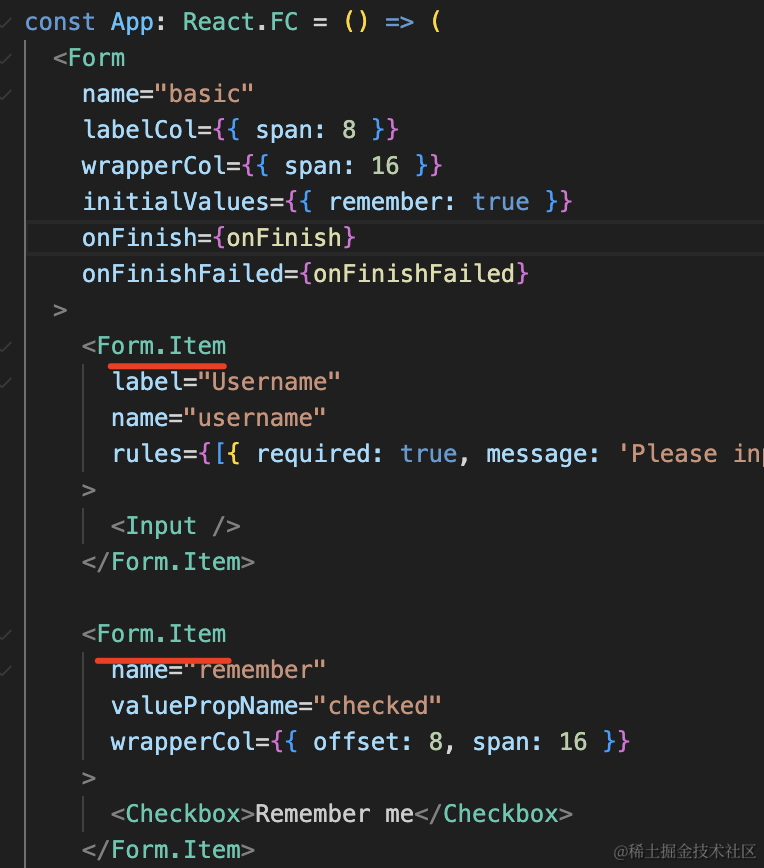
首先是参数,可以传入 label、name、valuePropName、rules 等:
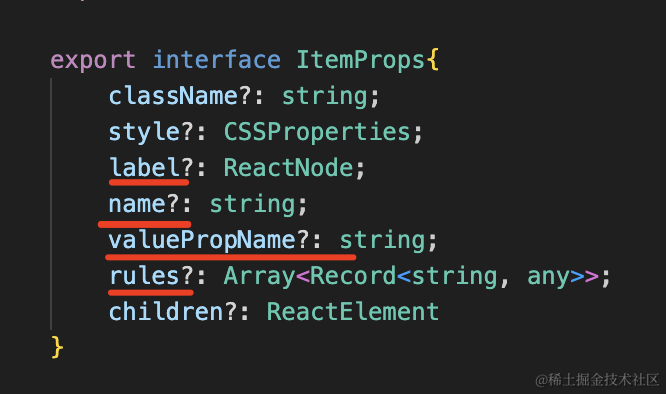
valuePropName 默认是 value,当 checkbox 等表单项就要取 checked 属性了:
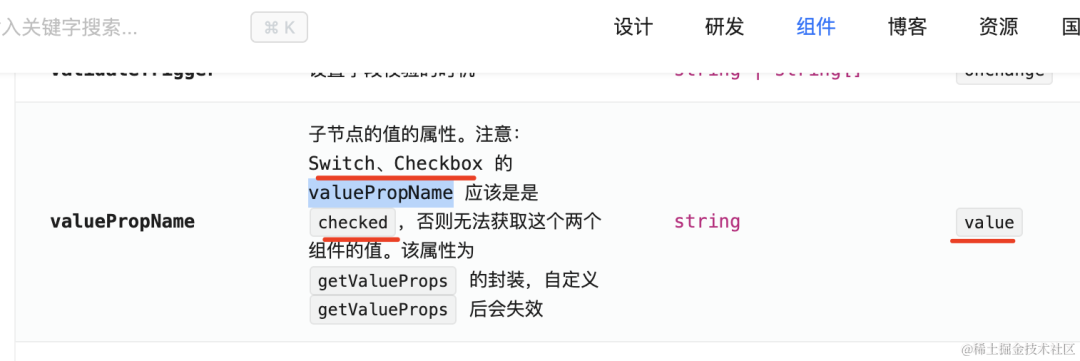
这里 children 类型为 ReactElement 而不是 ReactNode。
因为 ReactNode 除了包含 ReactElement 外,还有 string、number 等:

而作为 Form.Item 组件的 children,只能是 ReactElement。
然后实现下 Item 组件:
如果没有传入 name 参数,那就直接返回 children。

比如这种就不需要包装:
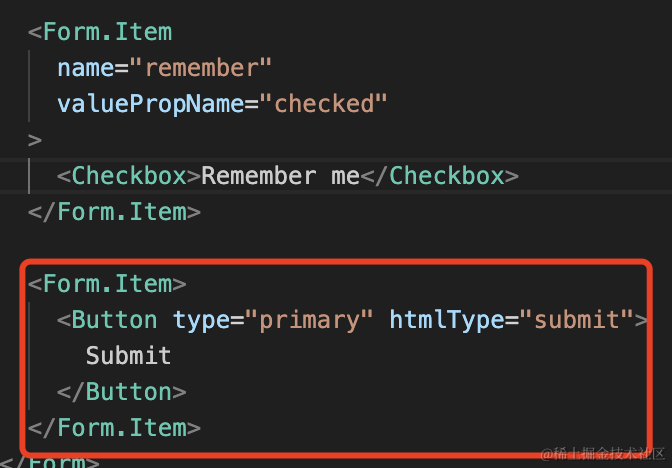
创建两个 state,分别存储表单值 value 和 error。
从 context 中读取对应 name 的 values 的值,同步设置 value:
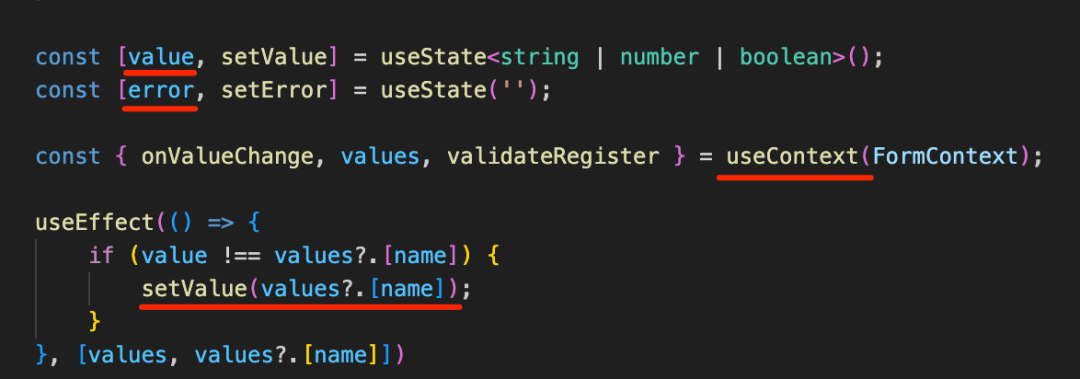
然后 React.cloneElement 复制 chilren,额外传入 value、onChange 等参数:
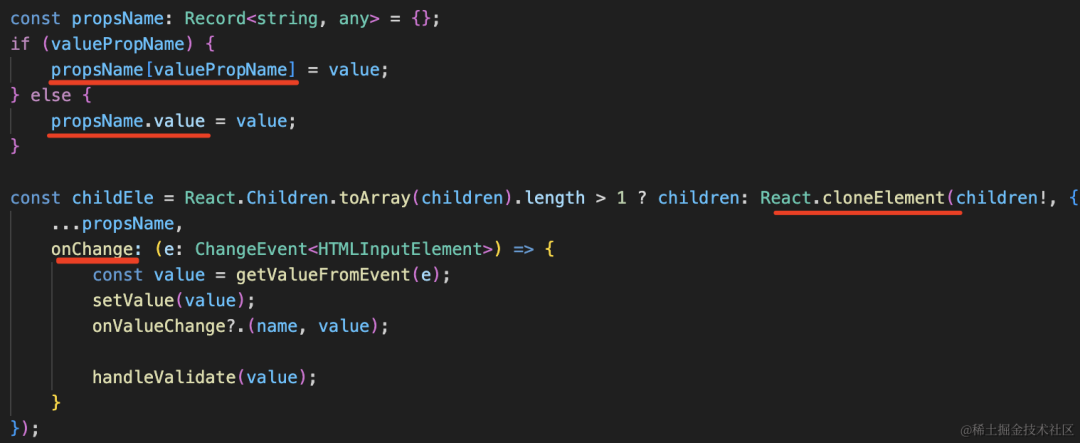
onChange 回调里设置 value,并且修改 context 里的 values 的值:

这里的 getValueFromEvent 是根据表单项类型来获取 value:
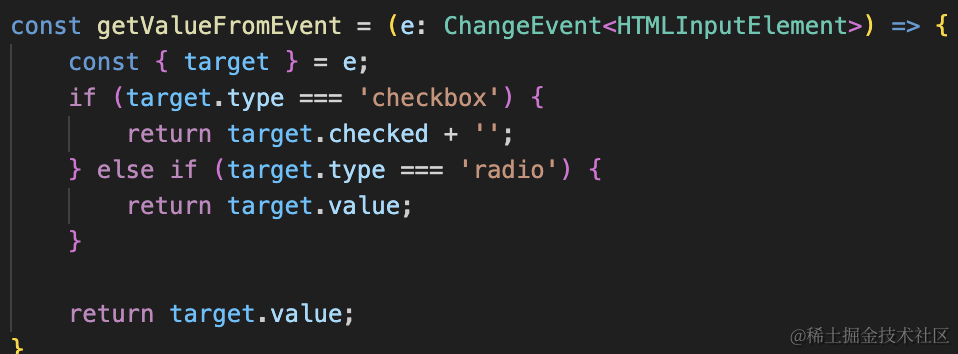
然后是校验 rules,这个是用 async-validator 这个包:
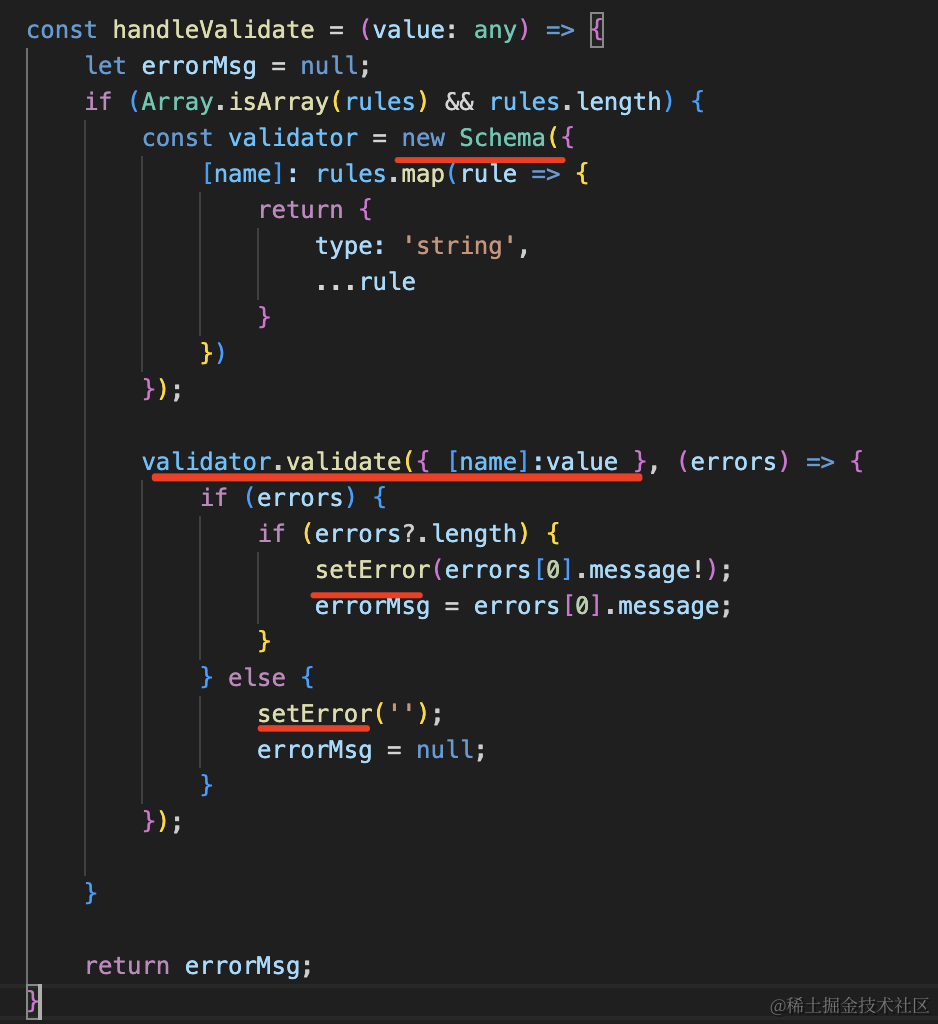
在 context 注册 name 对应的 validator 函数:

然后 Item 组件渲染 label、children、error
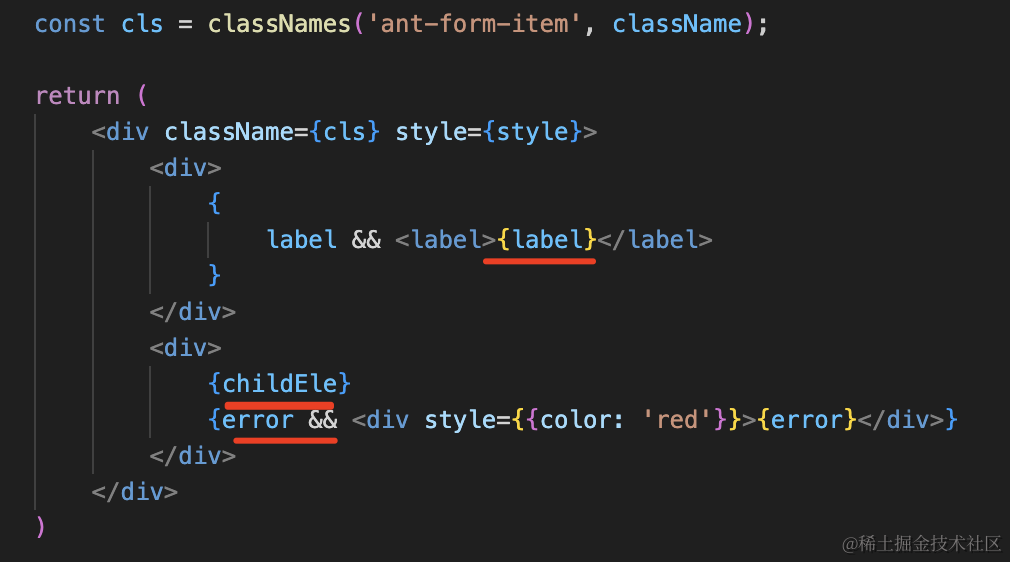
import React, { ReactNode, CSSProperties, useState, useContext, ReactElement, useEffect, PropsWithChildren, ChangeEvent } from 'react';
import classNames from 'classnames';
import Schema, { Rules } from 'async-validator';
import FormContext from './FormContext';
export interface ItemProps{
className?: string;
style?: CSSProperties;
label?: ReactNode;
name?: string;
valuePropName?: string;
rules?: Array<Record<string, any>>;
children?: ReactElement
}
const getValueFromEvent = (e: ChangeEvent<HTMLInputElement>) => {
const { target } = e;
if (target.type === 'checkbox') {
return target.checked;
} else if (target.type === 'radio') {
return target.value;
}
return target.value;
}
const Item = (props: ItemProps) => {
const {
className,
label,
children,
style,
name,
valuePropName,
rules,
} = props;
if(!name) {
return children;
}
const [value, setValue] = useState<string | number | boolean>();
const [error, setError] = useState('');
const { onValueChange, values, validateRegister } = useContext(FormContext);
useEffect(() => {
if (value !== values?.[name]) {
setValue(values?.[name]);
}
}, [values, values?.[name]])
const handleValidate = (value: any) => {
let errorMsg = null;
if (Array.isArray(rules) && rules.length) {
const validator = new Schema({
[name]: rules.map(rule => {
return {
type: 'string',
...rule
}
})
});
validator.validate({ [name]:value }, (errors) => {
if (errors) {
if (errors?.length) {
setError(errors[0].message!);
errorMsg = errors[0].message;
}
} else {
setError('');
errorMsg = null;
}
});
}
return errorMsg;
}
useEffect(() => {
validateRegister?.(name, () => handleValidate(value));
}, [value]);
const propsName: Record<string, any> = {};
if (valuePropName) {
propsName[valuePropName] = value;
} else {
propsName.value = value;
}
const childEle = React.Children.toArray(children).length > 1 ? children: React.cloneElement(children!, {
...propsName,
onChange: (e: ChangeEvent<HTMLInputElement>) => {
const value = getValueFromEvent(e);
setValue(value);
onValueChange?.(name, value);
handleValidate(value);
}
});
const cls = classNames('ant-form-item', className);
return (
<div className={cls} style={style}>
<div>
{
label && <label>{label}</label>
}
</div>
<div>
{childEle}
{error && <div style={{color: 'red'}}>{error}</div>}
</div>
</div>
)
}
export default Item;安装用到的 async-validator:
npm install --save async-validator然后在 Form/index.tsx 导出下:
import InternalForm from './Form';
import Item from './Item';
type InternalFormType = typeof InternalForm;
interface FormInterface extends InternalFormType {
Item: typeof Item;
}
const Form = InternalForm as FormInterface;
Form.Item = Item;
export default Form;主要是把 Item 挂在 Form 下。
在 App.tsx 测试下:
import { Button, Checkbox, Input } from "antd";
import Form from "./Form/index";
const Basic: React.FC = () => {
const onFinish = (values: any) => {
console.log('Success:', values);
};
const onFinishFailed = (errorInfo: any) => {
console.log('Failed:', errorInfo);
};
return (
<Form
initialValues={{ remember: true, username: '神说要有光' }}
onFinish={onFinish}
onFinishFailed={onFinishFailed}
>
<Form.Item
label="Username"
name="username"
rules={[
{ required: true, message: '请输入用户名!' },
{ max: 6, message: '长度不能大于 6' }
]}
>
<Input />
</Form.Item>
<Form.Item
label="Password"
name="password"
rules={[{ required: true, message: '请输入密码!' }]}
>
<Input.TextArea />
</Form.Item>
<Form.Item name="remember" valuePropName="checked">
<Checkbox>记住我</Checkbox>
</Form.Item>
<Form.Item>
<div>
<Button type="primary" htmlType="submit" >
登录
</Button>
</div>
</Form.Item>
</Form>
);
};
export default Basic;除了 Form 外,具体表单项用的 antd 的组件。
试一下:
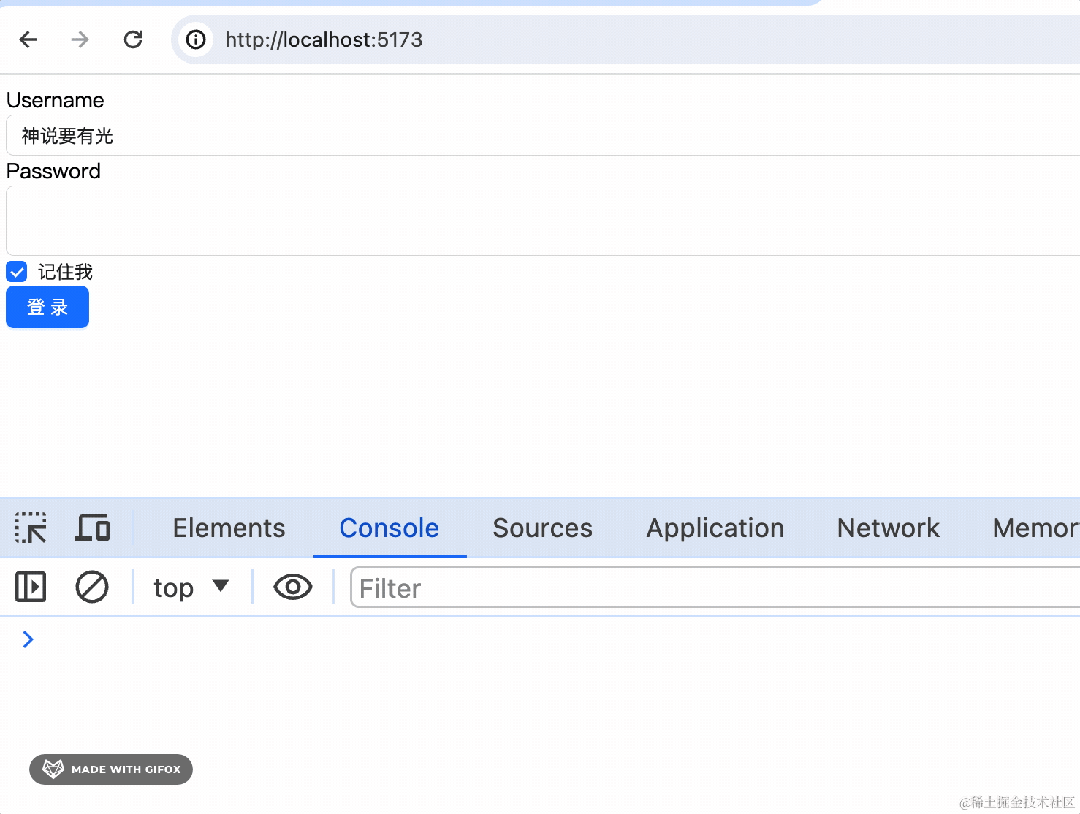
form 的 initialValues 的设置、表单的值的保存,规则的校验和错误显示,都没问题。
这样,Form 组件的核心功能就完成了。
核心就是一个 Store 来保存表单的值,然后用 Item 组件包裹具体表单,设置 value 和 onChange 来同步表单的值。
当值变化以及 submit 的时候用 async-validator 来校验。
那 antd 的 Form 也是这样实现的么?
基本是一样的。
我们来看下源码:
antd 的 Form 有个叫 FormStore 的类:
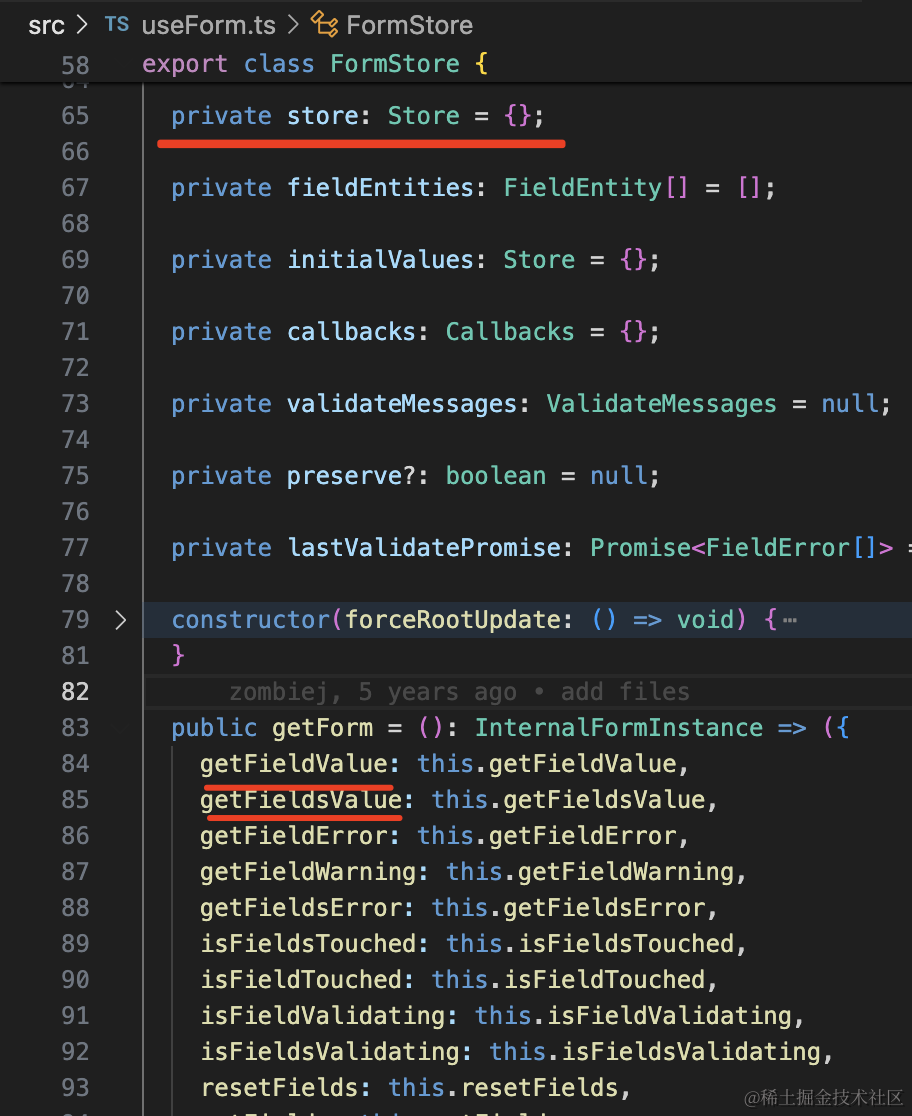
它的 store 属性保存表单值,然后暴露 getFieldValue、setFieldValue 等方法来读写 store。
然后它提供了一个 useForm 的 hook 来创建 store:
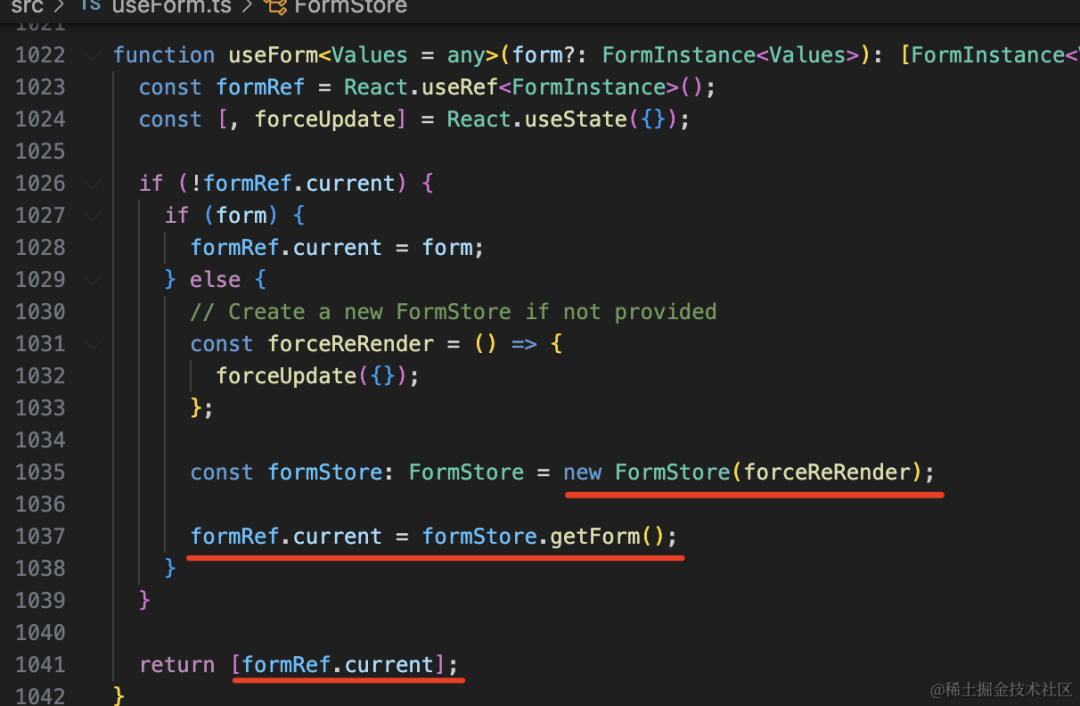
用的时候这样用:
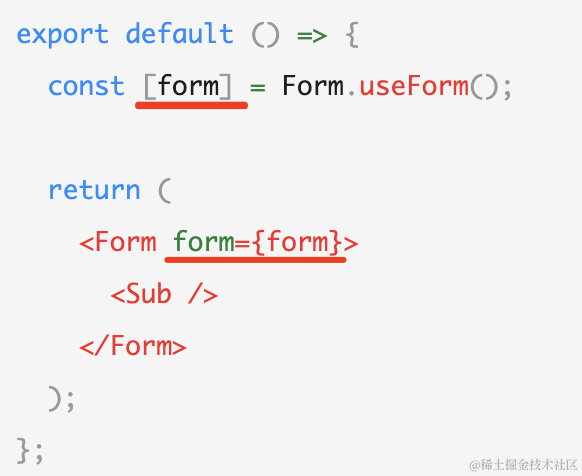
这样,Form 组件里就可以通过传进来的 store 的 api 来读写 store 了:
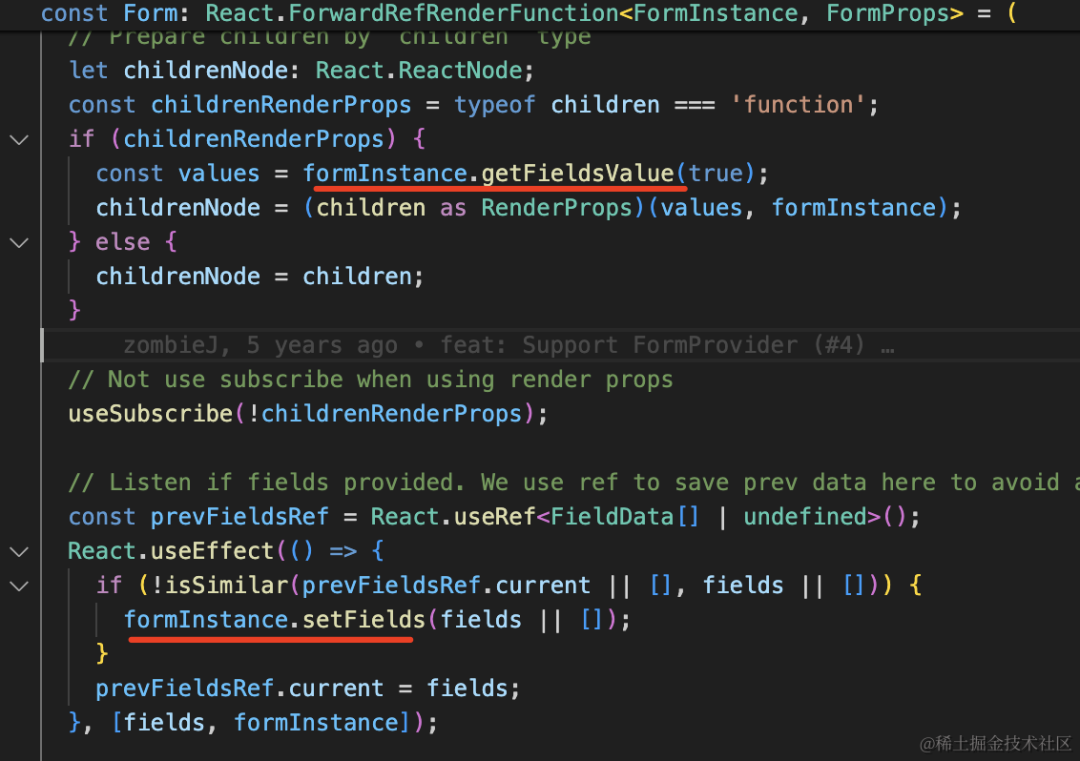
当然,它会通过 context 把 store 传递下去: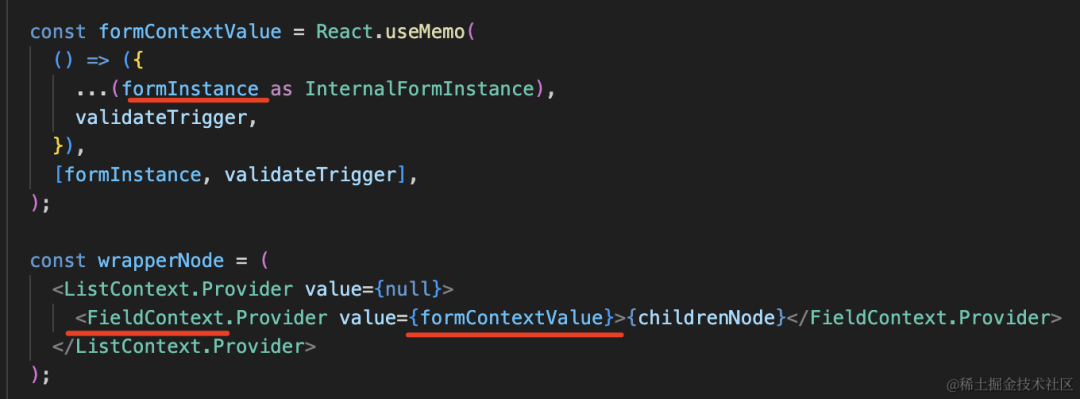
在 Field 也就是 Item 组件里就通过 context 取出 store 的 api 来读写 store:

和我们的实现有区别么?
有点区别,antd 的 FormStore 是可以独立出来的,通过 useForm 创建好传入 Form 组件。
而我们的 Store 没有分离出来,直接内置在 Form 组件里了。
但是实现的思路都是一样的。
提供个 useForm 的 api 的好处是,外界可以拿到 store 的 api 来自己修改 store。
当然,我们也可以通过 ref 来做这个:
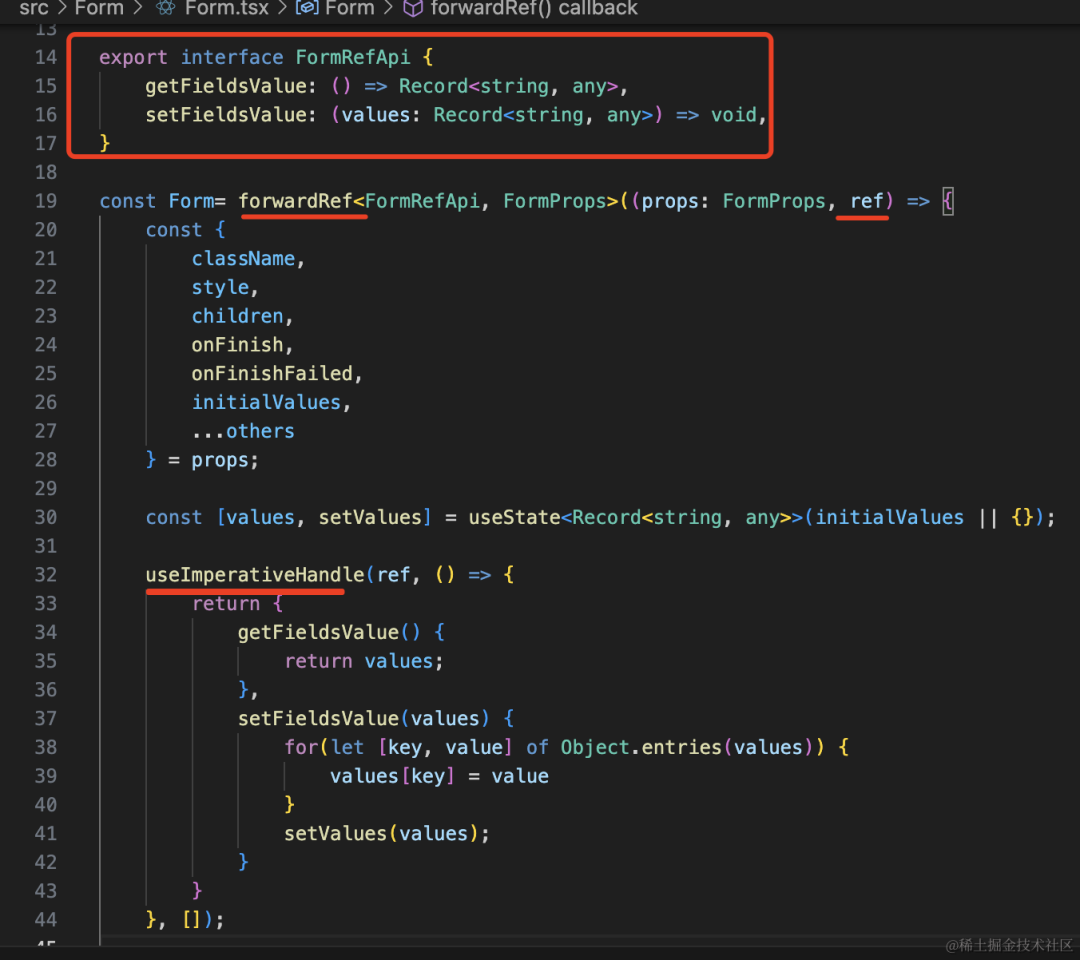
import React, { CSSProperties, useState, useRef, FormEvent, ReactNode, ForwardRefRenderFunction, useImperativeHandle, forwardRef } from 'react';
import classNames from 'classnames';
import FormContext from './FormContext';
export interface FormProps extends React.HTMLAttributes<HTMLFormElement> {
className?: string;
style?: CSSProperties;
onFinish?: (values: Record<string, any>) => void;
onFinishFailed?: (errors: Record<string, any>) => void;
initialValues?: Record<string, any>;
children?: ReactNode
}
export interface FormRefApi {
getFieldsValue: () => Record<string, any>,
setFieldsValue: (values: Record<string, any>) => void,
}
const Form= forwardRef<FormRefApi, FormProps>((props: FormProps, ref) => {
const {
className,
style,
children,
onFinish,
onFinishFailed,
initialValues,
...others
} = props;
const [values, setValues] = useState<Record<string, any>>(initialValues || {});
useImperativeHandle(ref, () => {
return {
getFieldsValue() {
return values;
},
setFieldsValue(values) {
for(let [key, value] of Object.entries(values)) {
values[key] = value
}
setValues(values);
}
}
}, []);
const validatorMap = useRef(new Map<string, Function>());
const errors = useRef<Record<string, any>>({});
const onValueChange = (key: string, value: any) => {
values[key] = value;
}
const handleSubmit = (e: FormEvent) => {
e.preventDefault();
for (let [key, callbackFunc] of validatorMap.current) {
if (typeof callbackFunc === 'function') {
errors.current[key] = callbackFunc();
}
}
const errorList = Object.keys(errors.current).map(key => {
return errors.current[key]
}).filter(Boolean);
if (errorList.length) {
onFinishFailed?.(errors.current);
} else {
onFinish?.(values);
}
}
const handleValidateRegister = (name: string, cb: Function) => {
validatorMap.current.set(name, cb);
}
const cls = classNames('ant-form', className);
return (
<FormContext.Provider
value={{
onValueChange,
values,
setValues: (v) => setValues(v),
validateRegister: handleValidateRegister
}}
>
<form {...others} className={cls} style={style} onSubmit={handleSubmit}>{children}</form>
</FormContext.Provider>
);
})
export default Form;然后在 App.tsx 试试:
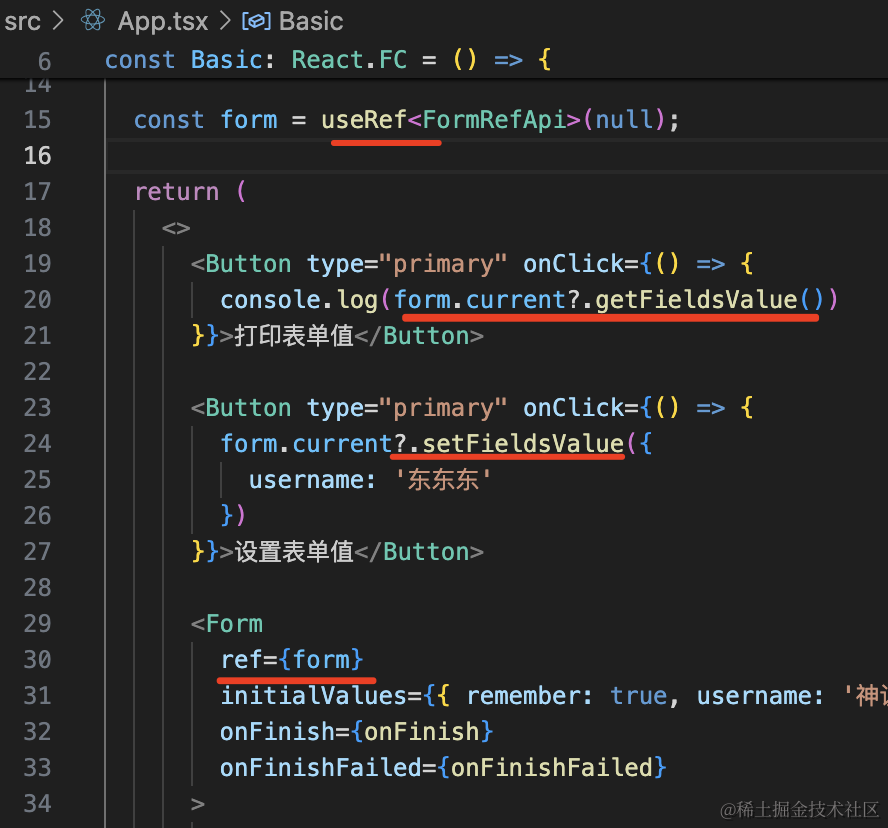
import { Button, Checkbox, Input } from "antd";
import Form from "./Form/index";
import { useEffect, useRef } from "react";
import { FormRefApi } from "./Form/Form";
const Basic: React.FC = () => {
const onFinish = (values: any) => {
console.log('Success:', values);
};
const onFinishFailed = (errorInfo: any) => {
console.log('Failed:', errorInfo);
};
const form = useRef<FormRefApi>(null);
return (
<>
<Button type="primary" onClick={() => {
console.log(form.current?.getFieldsValue())
}}>打印表单值</Button>
<Button type="primary" onClick={() => {
form.current?.setFieldsValue({
username: '东东东'
})
}}>设置表单值</Button>
<Form
ref={form}
initialValues={{ remember: true, username: '神说要有光' }}
onFinish={onFinish}
onFinishFailed={onFinishFailed}
>
<Form.Item
label="Username"
name="username"
rules={[
{ required: true, message: '请输入用户名!' },
{ max: 6, message: '长度不能大于 6' }
]}
>
<Input />
</Form.Item>
<Form.Item
label="Password"
name="password"
rules={[{ required: true, message: '请输入密码!' }]}
>
<Input.TextArea />
</Form.Item>
<Form.Item name="remember" valuePropName="checked">
<Checkbox>记住我</Checkbox>
</Form.Item>
<Form.Item>
<div>
<Button type="primary" htmlType="submit" >
登录
</Button>
</div>
</Form.Item>
</Form>
</>
);
};
export default Basic;
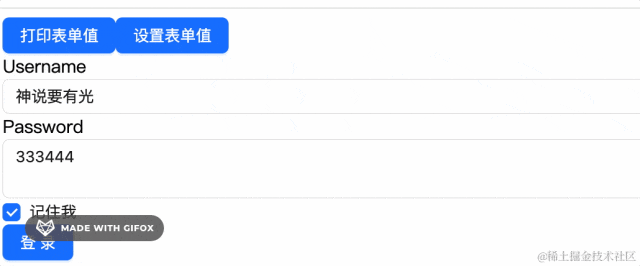
当然,你也可以把 store 的 api 处理出来,然后封装个 useForm 的 hook 来传入 Form 组件。
这样,用法比 ref 的方式简单点。
至此,我们就实现了 antd 的 Form 的功能。
案例代码上传了 react 小册仓库:https://github.com/QuarkGluonPlasma/react-course-code/tree/main/form-component
总结
我们每天都在用 antd 的 Form 组件,今天自己实现了下。
其实原理不复杂,就是把 Form 的表单项的值存储到 Store 中。
在 Form 组件里把 Store 放到 Context,在 Item 组件里取出来。
用 Item 组件包裹表单项,传入 value、onChange 参数用来同步表单值到 Store。
这样,表单项的值变化或者 submit 的时候,就可以根据 rules 用 async-validator 来校验。
此外,我们还通过 ref 暴露出了 setFieldsValue、getFieldsValue 等 store 的 api。
当然,在 antd 的 Form 里是通过 useForm 这个 hook 来创建 store,然后把它传入 Form 组件来用的。
两种实现方式都可以。
每天都用 antd 的 Form 组件,不如自己手写一个吧!
更多内容可以看我的小册《React 通关秘籍》





















 1万+
1万+

 被折叠的 条评论
为什么被折叠?
被折叠的 条评论
为什么被折叠?








